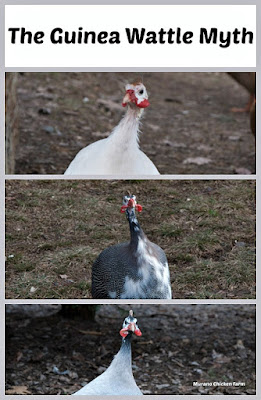I've heard several theories on how to tell them apart. The females tail makes a 'hump', the males have a smooth tail area. The girls have fluffier skirts so they can brood keets. The boys have pointed feathers, the girls have rounded feathers. Etc etc.
Do wattles tell which sex a guinea fowl is?
The only theory that I've heard that even comes close to being accurate is the one about their wattles. Both male and female guineas have rather prominent wattles. This theory says that the females have small wattles that point backwards, like the white female guinea in the top picture.
The males are said to have larger wattles that fold over and point down, like the male pied guinea in the center. Obviously, this sometimes holds true. There seems to be a good amount of guinea fowl that look like the lavender guinea in the third picture though. As you can see, one wattle is small and points backwards, the other is larger and folds over and points down.
Now, I'm not trying to break this theory wide open because after all, I don't have a definitive answer. I do know that the majority of guinea fowl that I have like with 2 different wattles are female. They do lay eggs. I have hatched their eggs with no problem. I've often wondered if there was some genetic issue, but they have been as healthy as any other Guinea and lived just as long.
While the Guineas in the pictures are different colors, color isn't relevant they just happened to be the only ones that wanted to stand still for me today! Honestly, I'm not sure what's going on and I'm pretty sure it really doesn't matter unless you're using this theory to purchase birds, in which case I wouldn't rely completely on this method.
The only method you can rely on 100% is the 'buck-wheat' test. This relies on hearing the guineas make their call so you can tell them apart. I have a few videos here: Sexing Guinea Fowl by sound. By using the sound test, you can always be sure when you have a female or male guinea.
Related reading: 7 Things you didn't know about Guinea fowl.
~L
Want information on raising chickens sent right to your email weekly? Click right here to join my list and get new posts sent directly to you the day they're published. You'll also get the free download 25 Ways to save money raising chickens.



As long as the guineas know the difference, that's what counts! Great post.
ReplyDeleteExactly! lol Thanks!
ReplyDelete~L
Either way, they are pretty birds...even if they are loud!
ReplyDeleteLoud isn't the word for it. LOL
ReplyDeleteThose things almost never shut up. I've heard my guineas making their stupid
"NAG NAG NAG!" in the middle of the night.
I was told that the way to tell the difference is that the males only make a 1 syllable noise that sounds like "Buck" and that the females make the 2 syllable noise that sounds like "Buck Wheat." But when you have 17 of them going off at the same time, good luck trying to figure out who sounds like what.
I agree that the sound is the best way to distinguish them apart. My son can tell by the sound that it makes if its a boy or girl. I have no idea so I depend on him. He's 8. He has about 30 guineas right now and he loves them. He knows, though, who hangs out with who and who is boyfriend or girlfriend with who. It's amazing to me!!!
DeleteYup, that is about the only way to definitely tell them apart. The female can make the male noise, but the males can't make the females noise. We have over 50 of them and boy does it get loud here! lol
Delete~L
Really interesting I had not idea. Would love you to share this on my Permanent Resource Guide for Guinea's: http://www.backyardfarmingconnection.com/2013/01/raising-other-backyard-birds-quail.html
ReplyDeleteSure thing. I'll do that right now, thanks!
Delete~L
I don't think they are any worse noise makers than the Canadian Geese. We have a single pair of Canadian Geese on our 3/4 acre pond. When strange geese land during brooding season, the gander can be heard a 1/4 mile away or more going off over the invader. During the fall, 80 + geese from surrounding ponds will use our riding arena to teach their young landing and take-off techniques into the pond.
ReplyDelete